Latest posts by (see all)
- The Best Things to Do in Tulsa - June 26, 2020
- The Most Interesting Things to Do in Springfield Mo - June 15, 2020
- Best Things to Do in Salt Lake City - May 26, 2020
- 10 Best Websites for Playing Online Games - May 22, 2020
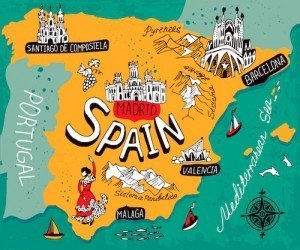 Spain is known not only for bullfighting, good beaches, passionate women, delicious paella and sangria. Spanish architecture is considered the most interesting in the world and really worthy of admiration. Spain has long attracted the attention of travelers and does not cease to receive millions of tourists from all over the world – it is consistently among the five most visited countries.
Spain is known not only for bullfighting, good beaches, passionate women, delicious paella and sangria. Spanish architecture is considered the most interesting in the world and really worthy of admiration. Spain has long attracted the attention of travelers and does not cease to receive millions of tourists from all over the world – it is consistently among the five most visited countries.
Places to visit in Spain attract with their eclecticism and diversity. The architectural appearance of cities for centuries was created not only by the ancestors of the Spaniards, but also by other peoples: during the walking tours one can find real Jewish and Arab neighborhoods, religious objects of different faiths – temples, churches, mosques. In the vicinity of the ancient cultural centers there were structures preserved that have remained from the ancient Romans.
In the major cities of Spain, hundreds of museums work, where curious archaeological finds, art objects, scientific achievements, sports attributes and other thematic collections are exhibited. Especially interesting are excursions to medieval castles and castles, in which the interiors of XIII-XV centuries are restored.
If you are choosing the country to spend vacation, Spain will be one of the best destinations as here you will be able to get a lot of new impressions and emotions.
Contents
- Place to visit number 1: The Sagrada Familia
- Place to visit number 2: Park Guell
- Place to visit number 3: The Boulevard Las Ramblas
- Place to visit number 4: Plaza Catalunya
- Place to visit number 5: The Gothic Quarter (Barrio Gótico)
- Place to visit number 6: Montjuic
- Place to visit number 7: Port Aventura
- Place to visit number 8: Mila House
- Place to visit number 9: Monastery of Montserrat
- Place to visit number 10: The Plaza of Spain
- Place to visit number 11: The Museum of Modern Art of Catalonia
- Place to visit number 12: The Museum of Marijuana
- Place to visit number 13: The Chocolate Museum
- Video
Place to visit number 1: The Sagrada Familia
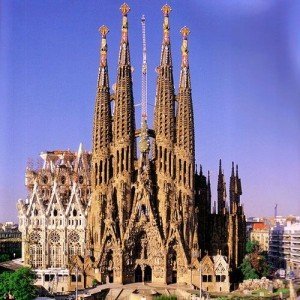 The full name is “The Expiatory Temple of the Holy Family” is the creation of the famous master of Spanish architecture Antonio Gaudi, who worked on the design and construction of the building for 43 years. The temple was to realize, according to the master’s plan, the main ideas of the New Testament. But Gaudi did not manage to see the greatest project of his life with his own eyes as he died in 1926 and the completion of the works was confined only to 2024 – one hundred years after his death.
The full name is “The Expiatory Temple of the Holy Family” is the creation of the famous master of Spanish architecture Antonio Gaudi, who worked on the design and construction of the building for 43 years. The temple was to realize, according to the master’s plan, the main ideas of the New Testament. But Gaudi did not manage to see the greatest project of his life with his own eyes as he died in 1926 and the completion of the works was confined only to 2024 – one hundred years after his death.
In the architecture of the building the styles of Neo-Gothic and Art Nouveau were mixed:
- strict, symmetrical details of the building, covered with ornate patterns,
- stained-glass windows,
- sculptural compositions depicting Biblical subjects,
- spiral staircases,
- four elegant towers, illuminated by a shimmering backlight, have long been the most iconic image of Barcelona.
Services in the church are already underway and the donations left by the parishioners are the main means of construction. At the height of the season, at the door of the church, there is often a queue of those who want to look at its fantastic decoration – so it’s better to come there when you have much free time.
Interesting: Inside the church visitors will find the Gaudi Museum and an observation deck with a breathtaking view of the fabulous Barcelona.
Back
Place to visit number 2: Park Guell
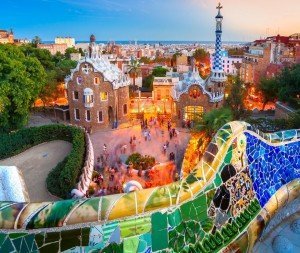 Park Guell is an incredibly beautiful place designed to create a private residential complex that would resemble the popular style of construction in England, which is a garden city. The creation of the garden city was ordered by Eusebi Güell, the Spanish philanthropist, whose name the complex got.
Park Guell is an incredibly beautiful place designed to create a private residential complex that would resemble the popular style of construction in England, which is a garden city. The creation of the garden city was ordered by Eusebi Güell, the Spanish philanthropist, whose name the complex got.
In 1901, work began on the creation of a park on this land. They were conducted in several stages:
- first, the slopes of the hill were fortified and equipped,
- then access roads were built,
- walls and entrance pavilions were built,
- and at the final stage, several houses were planned to be built on the sites sold and a famous winding parapet bench was built around the huge terrace area .
The main work on the design and construction of amazing, quaint little houses, ornate paths for walks and alleys was performed by the famous Catalan architect Antonio Gaudi, whose works are considered to be real works of art. In the Park Güell there is also located House of Gaudi, frequently visited by tourists. It is furnished with furniture and other things designed by the architect himself. By right the most beautiful place in the Park Güell is the square located next to the central entrance. Unusual buildings as if embodied in life with pictures, are admired not only as grandiose architectural ideas, but also as unique works of sculptural art.
Interesting: in 1984, this unusual park was inscribed on the UNESCO World Heritage List.
Back
Place to visit number 3: The Boulevard Las Ramblas
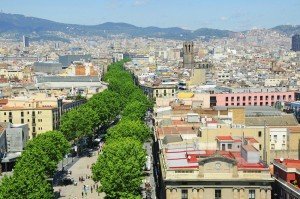 In the place where now the boulevard Las Ramblas is, once the river flowed. With it the name of the street is connected – in Arabic, the word “ramblah” means “dried river bed”. In a sense, the river has not disappeared from this place – in our days an endless stream of tourists “flows” here every day. This is the most important pedestrian and tourist artery of Barcelona, where there are:
In the place where now the boulevard Las Ramblas is, once the river flowed. With it the name of the street is connected – in Arabic, the word “ramblah” means “dried river bed”. In a sense, the river has not disappeared from this place – in our days an endless stream of tourists “flows” here every day. This is the most important pedestrian and tourist artery of Barcelona, where there are:
- palaces,
- theaters,
- museums,
- churches,
- the market,
- numerous open verandas of the cafe are located.
Life here is very active. It doesn’t stop even for a minute. An inalienable part of the boulevard of Las Ramblas there are living statues standing along the entire street to the monument to Christopher Columbus: they are animators depicting a dragon, a pharaoh, a mermaid, a butterfly, a cowboy, an angel and a demon and even a man on the toilet. It is only worth to throw a coin, as soon as the statue comes to life.
Interesting: Among tourists, Las Ramblas enjoys great popularity, behind, perhaps, only the famous Temple of the Holy Family is.
Back
Place to visit number 4: Plaza Catalunya
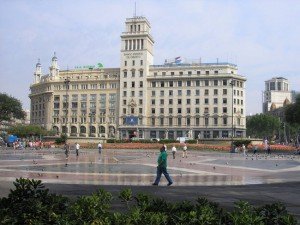 Plaza Catalunya is one of the most popular attractions in Barcelona. It is located between the Old Town and the Eixample district. Here there are two most famous streets of Barcelona:
Plaza Catalunya is one of the most popular attractions in Barcelona. It is located between the Old Town and the Eixample district. Here there are two most famous streets of Barcelona:
- Rambla,
- Peso de Gracia.
Until the middle of the XIX century the territory on which the Plaza Catalunya stretched was an ordinary countryside outside the city walls. In 1858, permission was received to demolish the barrier walls from the central government in Madrid. Thanks to this, it became possible to start active construction on the
adjacent land. By 1888, the architectural ensemble of the square was practically formed, after which it was repeatedly modernized. The area is paved with a stone, and around it there are several small fountains and many sculptures. More recently, in 1991, a collection of monuments of this square was replenished with a monument dedicated to the former president of the Catalan government Francesco Masia. Its author is the architect Josep Subirax, who took part in the construction of the monumental cathedral of the Holy Family.
Interesting: The most significant changes were made to the appearance of the Plaza Catalunya in 1929, when the city was preparing for the International Exhibition and a metro station was built.
Back
Place to visit number 5: The Gothic Quarter (Barrio Gótico)
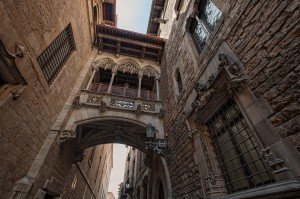 The Gothic Quarter is located in the center of the Old Town in Barcelona. It extends from Via Laetane and La Rambla to Plaça Catalunya. The name “Gothic” quarter received for a huge number of buildings that were built in the Middle Ages, during the reign of the Aragonese Crown – one of the most influential states of the Mediterranean. The Gothic quarter is located between Rambla and Laetane Street. Despite the fact that many buildings here date from the 14th and 15th centuries, there are plenty of:
The Gothic Quarter is located in the center of the Old Town in Barcelona. It extends from Via Laetane and La Rambla to Plaça Catalunya. The name “Gothic” quarter received for a huge number of buildings that were built in the Middle Ages, during the reign of the Aragonese Crown – one of the most influential states of the Mediterranean. The Gothic quarter is located between Rambla and Laetane Street. Despite the fact that many buildings here date from the 14th and 15th centuries, there are plenty of:
- cozy restaurants,
- expensive shops,
- lively night clubs.
The layout of buildings is very chaotic, which is typical for medieval cities. The block itself is an intersection of narrow curves of streets, the passage through many of which is forbidden. Many buildings were built in the XIV-XV centuries, but some of them were founded during the Roman Empire.
Interesting: Here and there even the whole Roman streets were preserved. They are popular places for walking tourists.
Back
Place to visit number 6: Montjuic
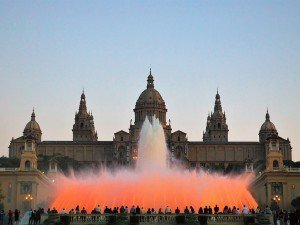 The magical fountain of Montjuic is a streaming spectacle under the open sky. The magic fountain began its work at the international exhibition Fair and Universal, where in 1929 (the year of the opening) it became the main decoration of the event. Since then, the fountain never ceases to amaze those looking at it. By the way, in 1992, the magic of sound was added to the magic of color. The fountain
The magical fountain of Montjuic is a streaming spectacle under the open sky. The magic fountain began its work at the international exhibition Fair and Universal, where in 1929 (the year of the opening) it became the main decoration of the event. Since then, the fountain never ceases to amaze those looking at it. By the way, in 1992, the magic of sound was added to the magic of color. The fountain
began to dance both for classical and popular tunes. The dance floor of Font Màgica does not repeat throughout the show. The show takes place in the evenings and lasts only 20 minutes, but this is enough to fall in love with this delightful action.
The combination of the graceful movements of the fountain and classical music creates a sense of sublimity and involvement in something very light and insanely interesting. Every year here, in honor of the end of the Catalan festival La Merce̒, there is a large “pyro-musical” show with an abundance of:
- fireworks,
- music,
- lasers.
Concerning the fountain, it should be added that it uses only circulating water, which saves drinking water for the municipality.
Interesting: Fountain area of 3 thousand square meters is decorated with the park Montjuic and the National Palace.
Back
Place to visit number 7: Port Aventura
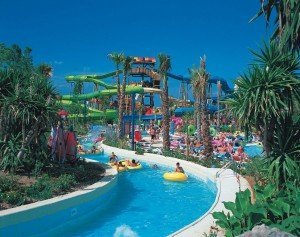 Port Aventura is not in vain considered the most visited park in Spain – everything was done here so that visitors could not only relax and have fun, but also that they were as comfortable as possible. For example, just 30 minutes from here there are:
Port Aventura is not in vain considered the most visited park in Spain – everything was done here so that visitors could not only relax and have fun, but also that they were as comfortable as possible. For example, just 30 minutes from here there are:
- two airports for the most inveterate travelers,
- several hotels – for those who would like to relax more thoroughly,
- and, finally, the water park for lovers of relatively active recreation.
In the park there is a place for everyone, because it is divided into six “worlds”, where everyone will find something to their liking! Whether the Mediterranean with its high-speed attraction Furius Baco (analog of the “roller coaster”) or landscapes of the Wild West with its cowboy spirit and water attractions. Those who prefer exoticism in all their manifestations can go to Mexico, China or Polynesia – a wide choice, is not it?
Interesting: For the smallest guests of the park there is a sixth part – Sesame, where there are attractions even for toddlers.
Back
Place to visit number 8: Mila House
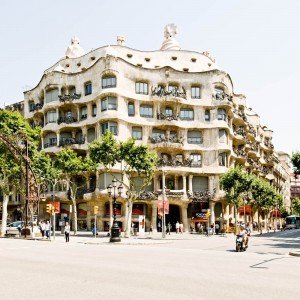 The house of Mila was designed by the architect Gaudi for the Mila family. For the strangeness of the structure, reminiscent of the image of a stone mountain with a number of caves, the House of Mila was called “La Pedrera”, which means “quarry” or “stone cave”.
The house of Mila was designed by the architect Gaudi for the Mila family. For the strangeness of the structure, reminiscent of the image of a stone mountain with a number of caves, the House of Mila was called “La Pedrera”, which means “quarry” or “stone cave”.
This is a unique structure, in which there are:
- no bearing and supporting walls;
- all floors are supported by columns;
- partitions inside the apartments can be freely moved;
- on the roof of the house there is a terrace where there are benches for rest and small bridges, bright ceramics and colored glass, and where chimneys resemble mysterious creatures.
The decoration of the balconies is made in the form of real lace made of wrought iron. The design of the building reflects the theme of natural motifs (caves, the sea, the underwater world), which has always been true to Gaudi.
Interesting: The Mila House was declared a World Heritage Site by UNESCO in 1984. It houses a museum dedicated to the work of Gaudi.
Back
Place to visit number 9: Monastery of Montserrat
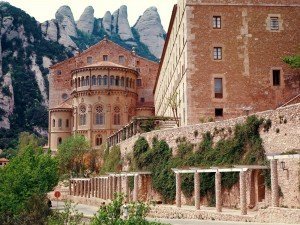 This is the oldest Benedictine monastery in Spain. It is located on the high mountain of the same name. Over the centuries, this amazing mountain with its many peaks was a source of inspiration for many artists, musicians, and poets. As if a magnet this place attracted:
This is the oldest Benedictine monastery in Spain. It is located on the high mountain of the same name. Over the centuries, this amazing mountain with its many peaks was a source of inspiration for many artists, musicians, and poets. As if a magnet this place attracted:
- travelers,
- pilgrims,
- climbers.
The monastic complex, dedicated to the Blessed Mother of God, is located at an altitude of 725 meters above sea level.
Its story is connected with a beautiful legend that once in ancient times in one of the caves the shepherds found a small wooden statue of the Madonna with the baby in her arms. The found statuette possessed the gift of miracles. In 1025, the abbot of Ripole – Oliba founded a new monastery on this site and dedicated it to
the Holy Mother of God Montserrat. During its long history, the monastery witnessed many events, both sad and joyful. It survived the separation and transformation into an independent abbey, the construction of a library, a strong destruction by Napoleon’s troops and ruins as a result of the Civil War in 1936. Now the monastery is home to 80 ministers of the statute of St. Benedict, who spend their days in constant work and prayer. From all Catalonia, thousands of pilgrims flock here. People go to bow to “Morenet” – so lovingly the Catalans call the patroness of their country.
Interesting: In the monastery you can listen to the amazing singing of the boys of the choir La Escolania, which has existed since ancient times.
Back
Place to visit number 10: The Plaza of Spain
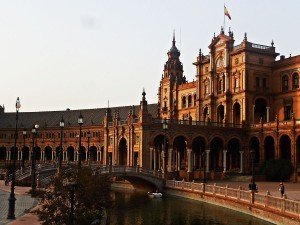 It is located at the foot of the Montjuic Mountain being one of the central squares of Barcelona. Its construction was timed to coincide with the International Exhibition of 1929. The Plaza de España has become the main exhibition area and since then it has been the main entrance to Montjuic. This place is popular thanks to:
It is located at the foot of the Montjuic Mountain being one of the central squares of Barcelona. Its construction was timed to coincide with the International Exhibition of 1929. The Plaza de España has become the main exhibition area and since then it has been the main entrance to Montjuic. This place is popular thanks to:
- The architect Huhol, a pupil of Gaudi, who designed the area in such a way that the main spatial dominant is the giant fountain located in the center, decorated with sculptures by the famous Catalan master Mikel Blay.
- This attraction was equipped in accordance with the latest technical innovations of the time – in the rhythm of the music dancing brightly illuminated by electricity water jets.
Recently, the fountain has been restored and is very popular with the guests of Barcelona, who come here to see the colorful light and music performance.
Interesting: The beautiful and monumental area of Spain has become a true symbol of the unity and greatness of the Spanish nation.
Back
Place to visit number 11: The Museum of Modern Art of Catalonia
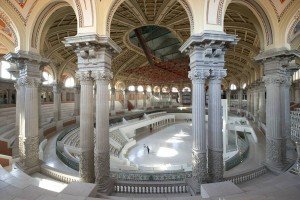 The National Palace is the visiting card of Catalonia, a grandiose structure built in 1926-1929 for the World Exhibition of 1929. The area of the building is 30,000 square meters. The structure is made in the classical style of the Spanish Renaissance and consists of a main rectangular part, two side parts and a back platform. On the building there are spotlights drawing the name of the city in the sky. Since 1934, the palace is the National Museum of Art of Catalonia – a
The National Palace is the visiting card of Catalonia, a grandiose structure built in 1926-1929 for the World Exhibition of 1929. The area of the building is 30,000 square meters. The structure is made in the classical style of the Spanish Renaissance and consists of a main rectangular part, two side parts and a back platform. On the building there are spotlights drawing the name of the city in the sky. Since 1934, the palace is the National Museum of Art of Catalonia – a
museum in Barcelona, created in 1990 as a result of the unification of the collections of the Museum of Art. The museum’s collections number about 236,000 masterpieces. They cover the thousand-year history of:
- Catalan,
- Spanish,
- European art from Romanticism,
- Gothic,
- Renaissance,
- Baroque,
- Modernism,
- Avant-garde.
Interesting: The museum has numismatic and engraving departments, as well as a universal and art library. In addition to the organization of various exhibitions, the museum also includes restoration and conservation works.
Back
Place to visit number 12: The Museum of Marijuana
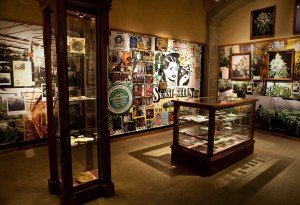 This museum is one of the youngest museums in Barcelona, located in the historic center of the city in a 15th-century building on Palau Mornau. In the past, it belonged to the Sanclement family and in 1908 it was renovated by the architect-modernist Raspalle.
This museum is one of the youngest museums in Barcelona, located in the historic center of the city in a 15th-century building on Palau Mornau. In the past, it belonged to the Sanclement family and in 1908 it was renovated by the architect-modernist Raspalle.
As a place for the museum, the building was chosen by the creator of a similar museum in Amsterdam by Ben Drockers back in 2003, after which the restoration work and coordination with the city administration began. The opening of the museum took place on May 9, 2012.
The museum has a huge number of exhibits devoted to cannabis and cultural phenomena associated with this plant:
- pictures,
- drawings,
- posters,
- various adaptations which were used for marijuana.
Particularly interesting there are the drawings of the 17th century by David Tenier, Jr., Cornelius Decker and Herman Saftleven.
Interesting: Also in the museum you can find a huge number of botanical drawings of the XVIII-XIX centuries.
Back
Place to visit number 13: The Chocolate Museum
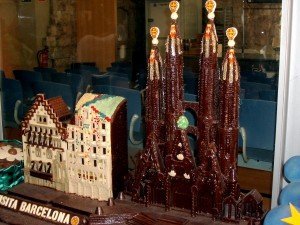 If you are a sweet tooth you should definitely visit the most delicious museum in Barcelona – the Chocolate Museum, founded by the Barcelona Confectioners Guild in the former convent.
If you are a sweet tooth you should definitely visit the most delicious museum in Barcelona – the Chocolate Museum, founded by the Barcelona Confectioners Guild in the former convent.
This museum is able to seduce anyone. After a journey through the historical paths of chocolate, do not deny yourself the pleasure and taste an exquisite delicacy. If you come to the Museum of chocolate for Easter, then you are lucky twice because at this time there is an unusual exhibition-competition of chocolate sculptures “Mona”. Monas are sculptures made of chocolate that can depict:
- famous buildings,
- people,
- cartoon characters.
Interesting: Producers of chocolate exhibit Monas in showcases on Easter week, trying to outdo each other in creativity and ingenuity. And what a museum of chocolate can do without a cafe, which serves hot chocolate and other delicacies!
Back